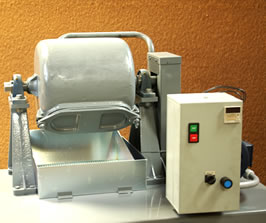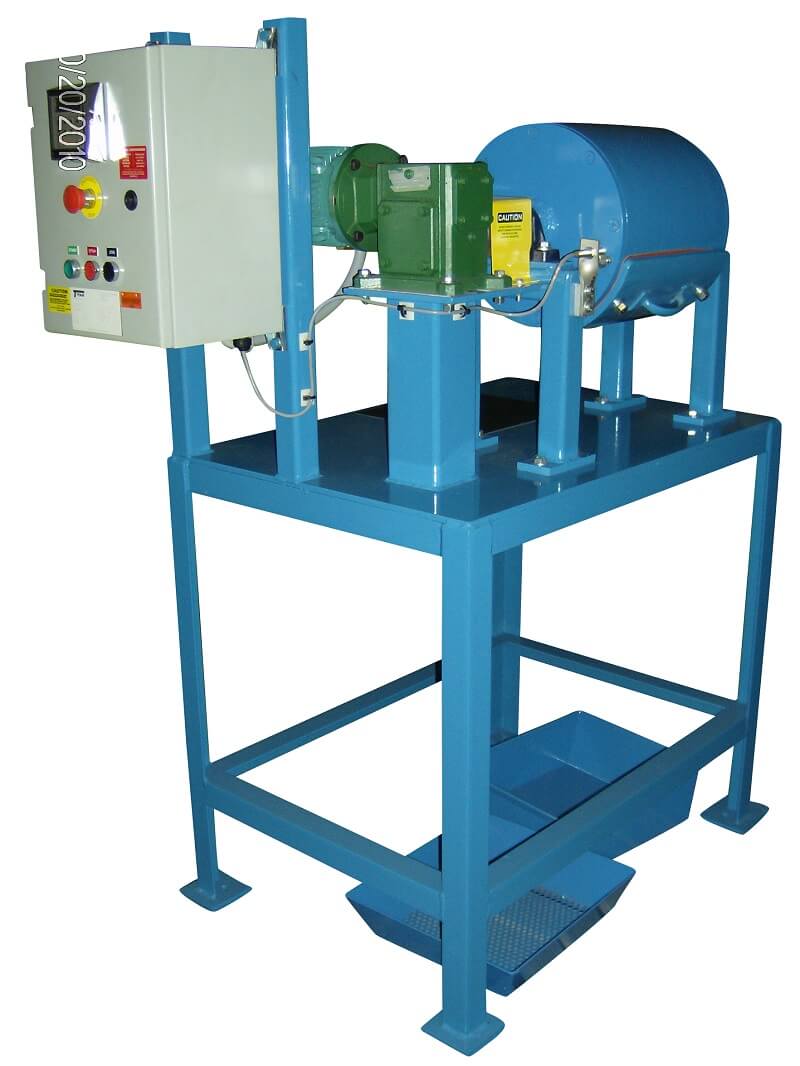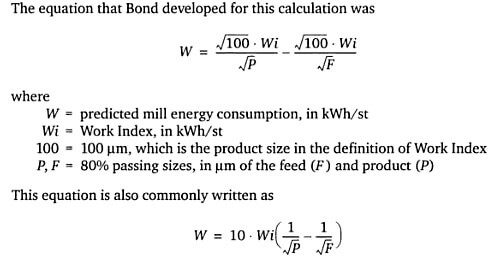 This Grindability Test or Bond Ball Mill Work Index Procedure is used to determine the Bond Work Index of minus six mesh or finer feed ore samples. These equation application methods are used to process <1/2″ ore samples in a Ball Mill using a standard ball charge.
This Grindability Test or Bond Ball Mill Work Index Procedure is used to determine the Bond Work Index of minus six mesh or finer feed ore samples. These equation application methods are used to process <1/2″ ore samples in a Ball Mill using a standard ball charge.
Below describes in general terms the Bond Work Index Procedure used by a Professional Metallurgical Testing Laboratory. If you think the equation is complicated, wait until you try using that famous Bond Work Index equation Mr. Fred worked so hard at.
The F.C. Bond Ball Mill is a small universal laboratory mill used in calculating the grindability of all ores.
GRINDABILITY IS THE NUMBER OF NET GRAMS OF SCREEN UNDER-SIZE PRODUCED PER REVOLUTION OF THE MILL.
The Ball Mill Charge:
- Clean the Ball Mill and accessory equipment before starting.
- Count and weigh the Balls by sizing group. Record the results on the Ball Count and Charge Weight Determination form.
- Determine a charge weight made up of exactly 285 steel Balls weighing as close to 20,125 grams as possible.
- Adjust the final weight up or down by substituting one Ball of one size with a new Ball of the same size, maintaining an exact count of 285 steel Balls.
- 25 balls of 1-1/2″
- 39 balls of 1-1/4″
- 60 balls of 1″
- 68 balls of 7/8″
- 93 balls of 3/4″
For a total of 285 balls and around 44.5 lbs.
Preparation of Test Feed Sample for Bond Work Index Procedure:
- Riffle 8-10 kilograms of minus half an inch feed into 500 gram charges.
- Riffle one 500 gram charge of ore down to splits of 125 grams each.
- Record the exact weight of one split; identify it as Feed No. 1. Wet screen through a 150 mesh screen.
- Filter and dry the +150 mesh and screen through the 6-150 mesh screen deck.
- Record the weight of each size fraction on the Bond Feed Screen Analysis Worksheet.
- Repeat the procedure with a second split identified as Feed No. 2. Record the exact weight of the sample before proceeding.
- Input the screen analysis data.
- Calculate the K80 values and percent of less than 150 mesh product. Complete for each of Feed No. 1 and Feed No. 2:
- If the K80 values are within 50 microns of each other then proceed to step 9
- If the K80 values have a greater than 50 microns spread then repeats the screen analysis with a new split identified as Feed No. 3, starting at step 3.
- If the K80 values of Feed No. 2 and Feed No. 3 are within 50 microns of each other then proceed to step 9

9. Enter the combined sizing data from Feed No. 1 and No. 2 (or No. 2 and No. 3) into a new Bond Feed Screen Analysis sheet and calculate the K80 and the average percent of less than 150 mesh product.
10. Record the K80 in um as factor, F, on your Bond Mill Grindability Test-sheet.
11. Record the percent of the under-size, i.e. less than 150 mesh product.
The Grind Test:
- Tare a clear graduated 1 liter cylinder.
- Add a prepared 500 g charge slowly, in 100 ml increments, to the cylinder on a vibrator until 700 ml is obtained. Vibrate two minutes between additions.
- Vibrate an additional five minutes. Add additional ore and vibrate to obtain 700 ml of compacted ore.
- Record the weight of 700 ml of ore on Bond Mill Grindability Test Worksheet. This represents the feed weight required for the first and each subsequent grinding cycle.
- Empty the weighed and measured feed from the graduated cylinder into the Ball mill containing the measured charge.
- Seal the mill and grind the ore for 100 revolutions.
- Empty the mill contents carefully and completely into the ball tray using a brush.
- Screen out the ball charge, cleaning the balls and returning then to the mill.
- Brush the ground product from the ball screen and tray onto a square kraft paper. Split the product roughly into thirds.
- Set up three screen stacks of 20 mesh, 150 mesh and a divider pan. Add a product cut to each. Build as one deck.
- Place the deck on the Ro-Tap for 15 minutes.
- Record the weight of the oversize and calculate the weight of the under-size on the Bond U/S Percent Weight Worksheet.
- Repeat screening the oversize until the under-size is less than five percent of the original under-size, recording the data on the Worksheet. Save and identify the under-size of this 1st Cycle.
- Record the calculated weight of the under-size in the product column on the Worksheet.
- Open on the Bond Mill Grindability Test template –> Bond Test Input.
- Input the data to calculate the number of revolutions required for Cycle 2.
- Add fresh un-segregated feed to the oversize to reestablish a weight equal to the original charge.
- Empty the new charge, identified as Cycle 2, into the prepared ball mill and grind for the required number of revolutions.
- Repeat the grinding cycles for a minimum of six cycles until the weight of the screen under-size product per revolution reaches equilibrium for two cycles and then reverses direction in the last cycle.
Under-size Product Preparation:
- Roll the under-size product sample from the last cycle 20 times to homogenize.
- Cut a 100-150 gram sub sample. Put it into a labeled Kraft bag for sizing.
- Bag the reject under-size product and store in a labeled box.
- Weigh 100 g of under-size product and record the weight on the Bond Screen Analysis sheet.
- Wet screen the 100 g Product through the 400 mesh.
- Filter and dry the >400 mesh. Screen through a 170-400 mesh screen deck.
- Record the weight of each screen fraction.
- Input the data related to your test Cycle Number.
- Calculate and record the K80 value.
BOND Work Index Calculations:
- Calculate the average value of the last three cycles Net/Rev
- Record the value.
- The Work Index (BWi) is calculated according to Fred Bond’s Equation.

Cleaning and Storing of Ball Mill Charge after the Bond Work Index Procedure is done:
- Add about 500 g of silica sand into the mill containing the ball charge.
- Seal the mill. Rotate for 20 revolutions to clean.
- Empty the mill charge and sand into the ball try once grinding is complete.
- Clean out the mill using a brush. Put the lid on the mill.
- Brush the sand from each Ball and place the clean Balls onto a pan.
- Store the clean steel balls in a cloth bag.
- Clean the Ball screen and sample tray. Discard the sand.
All this above is explained in details in video. Lots of work went into this one. Ouch!
The sample was crushed to 100% passing 6 mesh (3.35mm), from this a 700 cc volume was measured and weighed to be used as feed for the Bond Mill. A feed particle size analysis was performed to determine feed P80 and % -106 micron. The sample was milled for 100 revolutions and passed over a 150 mesh (106µm) sieve, the undersize was removed from the samples, weighed, and new sample was added to the feed to maintain the initial sample weights. The number of rotations for the next milling was calculated based on the undersize sample weights. This was repeated until the milling produced stable results for three consecutive cycles.
The Bond grindability was calculated to be 1.21 g net undersize/revolution by averaging the results from the last 3 runs on the Bond Mill. The grindability is defined as the ease at which a mineral particle is reduced to a predetermined size and used to calculate the Work Index.
The feed and final undersize particle size analysis as well as the grindability test data sheet are found in the appendix.
